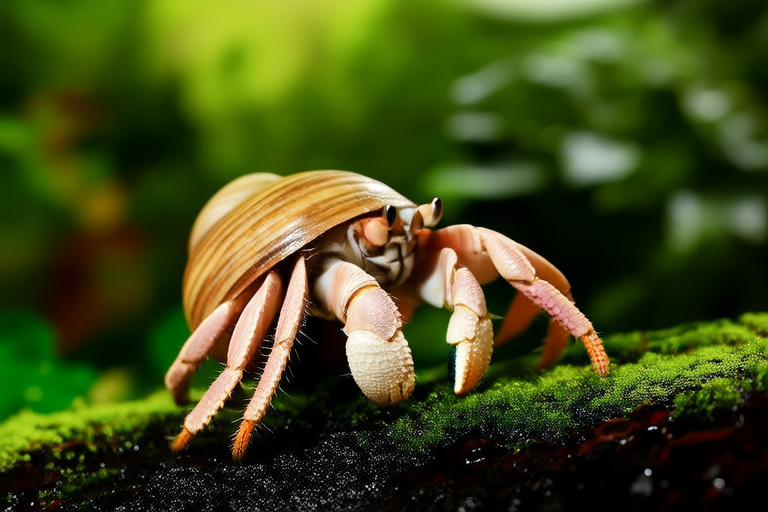Why Hermit Crabs Make Unique Pets (And How to Keep Them Thriving)
Hermit crabs have emerged as unconventional yet fascinating pets that captivate many animal enthusiasts. These crustaceans, unlike traditional pets like dogs or cats, offer a unique experience due to their intriguing behaviors and low maintenance requirements. They are particularly appealing to those looking for a pet that requires minimal space and provides an excellent educational opportunity for children.
The Appeal of Hermit Crabs as Pets
One of the most appealing aspects of hermit crabs is their ability to adapt to various environments, making them ideal for apartment dwellers or individuals with limited space. Their small size allows them to thrive in a relatively compact habitat, often requiring no more than a 10-gallon tank. Additionally, hermit crabs are nocturnal creatures, meaning they are most active during the night, which can be beneficial for those who work during the day.
Hermit crabs also provide an educational opportunity for children. Observing their behaviors, understanding their needs, and learning about their biology can spark curiosity and foster a love for nature. Moreover, hermit crabs are social animals, often found living in groups in the wild, which can encourage interaction among children and promote empathy.
Care Requirements for Hermit Crabs
Habitat Setup
Creating a suitable habitat is crucial for the well-being of your hermit crabs. The tank should be spacious enough to allow ample room for movement and exploration. A 10-gallon tank is typically sufficient for a small group of hermit crabs, but larger tanks are preferable for bigger groups. The substrate in the tank should be a mixture of sand and coconut fiber, providing a comfortable environment for burrowing and molting.
Temperature and Humidity Levels
Hermit crabs thrive in tropical conditions, requiring a consistent temperature range of 75-85°F (24-29°C). A heat lamp or under-tank heater can help maintain this temperature. Humidity levels are equally important, ideally ranging between 70-80%. A humidifier or regular misting can help achieve and maintain these levels.
Diet and Feeding
Hermit crabs are omnivores, feeding on a variety of foods. A balanced diet includes commercial hermit crab food, fruits, vegetables, and occasional protein sources like fish flakes or shrimp. Fresh water should always be available, along with a shallow dish of salt water for drinking and soaking. It’s essential to change both dishes regularly to prevent bacterial growth.
Tank Mates
Hermit crabs are social animals and can live harmoniously with others of their kind. However, it’s crucial to introduce new crabs gradually to avoid stress or aggression. Avoid housing hermit crabs with other species, as their dietary and environmental needs may differ significantly.
Ensuring Hermit Crabs Thrive
Shell Selection
Selecting appropriate shells is vital for hermit crabs. As they grow, they need to find larger shells to accommodate their expanding bodies. Providing a variety of shells of different sizes and shapes encourages natural behavior and minimizes stress. Shells should be cleaned thoroughly before being introduced into the tank to prevent any harmful substances from affecting the crabs.
Environmental Enrichment
To keep hermit crabs engaged and stimulated, it’s important to provide environmental enrichment. This can include hiding spots, climbing structures, and toys designed specifically for hermit crabs. These items not only enhance their physical health but also contribute to their mental well-being.
Handling Hermit Crabs Gently
When handling hermit crabs, it’s essential to do so gently and with respect for their natural instincts. Hermit crabs are delicate creatures, and rough handling can cause injury or undue stress. Always support the crab’s body when holding it, and avoid pulling on its legs or antennae. Regular interaction can help the crab become accustomed to handling, but it’s crucial to observe their comfort level and adjust accordingly.
Conclusion
Hermit crabs make unique and rewarding pets for those willing to provide the right environment and care. Their small size, low maintenance requirements, and educational value make them an excellent choice for individuals with limited space or families looking to teach children about responsibility and empathy. By following the care guidelines outlined above, you can ensure your hermit crabs thrive and enjoy a happy, healthy life. Remember to handle them gently and respect their natural instincts, and you’ll have a wonderful companion that brings joy and fascination to your home.
